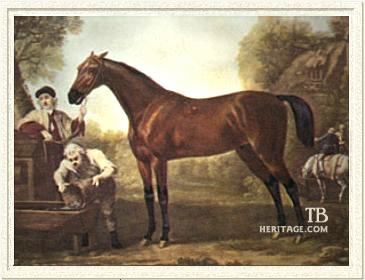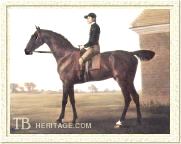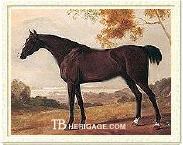|
|
Matchem

|
|
 |
|
|
A popular adage in the late Eighteenth and early Nineteenth Century went "Snap for speed, and Matchem for truth and daylight." Snap was a son of Snip (by Flying Childers), a brilliant racehorse with an influence in pedigrees for brilliant speed. Matchem represented something quite different, yet also essential, in the production of top runners: gameness and soundness.
Matchem was bred by John Holmes of Carlisle, in the northern English county of Cumberland. He was sired by Cade (by the Godolphin Arabian) who stood at Easby Abbey in Yorkshire, and out of a bay mare by Partner, bred by John Croft of Barforth.
Before racing, Matchem was sold to William Fenwick, who also owned his year-older full brother Changeling. Their dam, a full sister to the notable Miss Partner, is sometimes referred to as "Changeling's dam". It's curious that she'd be remembered that way in light of the more famous younger brother.
The Fenwick name was well-respected in equestrian circles. Sir John Fenwick was Master of the Horse to Charles I. In the inventory of the Royal Stud at Tutbury from 1649, there are listings for several horses of "Fenwick's Arabian Race", as if that were enough information to establish their value. Sir John owned the Fenwick Barb, a horse who lives on in the GSB via his son (Old) Whynot, sire of the Blackett's Snail (in the pedigree of Herod) and of Grey Whynot (the dam of the Bald Galloway, in the pedigree of all Thoroughbreds). A descendant, Edward Fenwick, Lord Ripon, moved to the American colony of South Carolina and established the famous John's Island Stud in 1750. He had much success in early racing there, largely through the exploits of his home sire, imported Brutus (by Regulus).
William Fenwick's stud was at Bywell in Northumberland, and this is the headquarters from which Matchem's racing career began. As was the norm for the period, he didn't go to the races until fully mature at the age of five years, in 1753. On the racecourse, he established himself as a horse who was very, very good, if not outstanding. His first race was the Great Subscription Purse at York, which he won, and repeated with a victory in a plate at Morpeth, Northumberland.
The next year, at six, he won the Ladies' Plate at York (4 mile heats), another Ladies' Plate at Lincoln, and a third plate at Morpeth.
As a seven-year-old, in 1775, he defeated the highly-regarded Trajan over the 4 mile Beacon course at Newmarket in a remarkable time of 7:20. Trajan's supporters claimed their horse was not at his best and his owner challenged Matchem's owner for The Whip in a rematch run in April of 1756 over the same course. Matchem affirmed the first result by winning with ease.
His next victory came in a plate at Newcastle; he then met with defeat for the first time at Newmarket in the Jockey Club Plate, beaten by Spectator. It was hard for Matchem to get back on track and he apparently had some physical problems during this period that took some time to resolve. In 1758, he was again defeated in the Jockey Club Plate at Newmarket, by Mirza, but he came back to win a plate at Scarborough over Foxhunter. In all, he ran a dozen times, winning ten, and gained the reputation of being a thoroughly genuine competitor, durable and honest, giving his best every time.
Matchem covered a few mares at Bywell during the 1758 season, but wasn't retired from racing until the folllowing year.
The most important son of Matchem in an historic sense was Conductor (ch.c. 1767) out of a mare by Snap, so combining the two famous stallions of the adage. Conductor was a good runner, a winner of ten races, and a good sire, his best including Trumpator and Imperator. Trumpator (blk.c. 1782) continued the male line into the next generation with his influential son, Sorcerer.
|

Pumpkin

Turf

Johnny
|
|
Matchem also sired the St. Leger winning filly Hollandaise (gr.f. 1775, out of Virago by Panton Arabian) and Oaks winner Teetotum (b.f. 1775, out of Lady Bolingbroke by Squirrel), both in his later years at stud. Other good ones include Pumpkin (ch.c. 1769, out of Pratt's Old Mare by Squirt), who is probably more famous now for the beautiful portrait of him painted by Stubbs.
Matchem also sired Turf, whose main claim to fame lies through a daughter, the dam of the important sire, imported Messenger, dam's sire of American Eclipse, and a foundation sire for Standardbreds and other gaited breeds. Other sons included Ranthos, Alfred, Espersykes and Johnny.
Johnny (1769), was a typically durable and successful Matchem son. Out of a Babraham mare, won seventeen races and received nine forfeits in twenty-nine starts over four seasons at Newmarket, with only four defeats in his career. He died in 1777, and had no offspring.
Matchem daughters were also influential, producing the likes of Bagot, Maid of the Oaks, Young Giantess, Brunette, Rattler, Rockingham, Eager, and Quiz. His daughters became important tap root mares: Marotte, Mop Squeezer, Teresa, Giantess, Atalanta, Rarity, Maiden, Mayfly, Pyrrha, Monimia, Miss West, and Puzzle among others.
In all, Matchem sired 354 winners, and his hallmark was excellent temperament and durability, the "truth and daylight" so desirable in breeding.
|
He was a small horse, only about 14.3 hands, of racey build with great length of body and density of bone. He was a bay of a dark shade with a little tracing of white on his left hind coronet. His progeny came in all colors, but it was said that many of his best descendants were chestnut with a higher than average representation of blacks as well. (Conductor was chestnut, Trumpator was black).
Another characteristic he was noted for was the "Matchem arms," white hairs appearing in two or three bars at the base of the tail. He also sired a large number of horses listed as "roan" out of non-roan mares. Since two non-roan parents aren't supposed to produce roans, given the scenario, it's likely that Matchem carried a gene for the "rabicano" color pattern, which results in scattered white hairs throughout a normally colored coat appearing like a roaning pattern, and also characterized by a "coon tail", white bars at the base of the tail. Regulus and Matchem's sire Cade also sired roans. While it's tempting to attribute this gene to their common male ancestor, the Godolphin Arabian, it's also worth noting that Regulus and Cade were both out of mares by a horse named The Bald Galloway, who, by his name alone, is a more likely source of the rabicano or similar sabino pattern.
Matchem lived to the ripe old age of 33, dying at Bywell on February 21, 1781.
--Anne Peters
|
|
|
|

